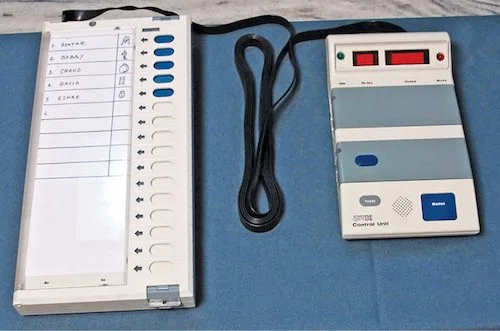What is the full form of EVM?
The EVM full form is Electronic Voting Machine. EVM is a gadget that electronically records votes. It is a device used to implement electronic voting in State and General Elections in India.
Read Other Full Forms
Structure of EVM
A five-meter cord is used to link the two components of an Electronic Voting System.
- Control unit – Located within the polling or presiding officer’s office.
- Ballot unit — That section of the voting compartment that contains the ballots.
Instead of releasing a voting paper, the polling officer in charge of the Control Unit will issue a ballot by hitting the Ballot button on the Control Unit. On the voting gadget, the voter will be required to indicate his support by clicking the blue button next to the candidate’s name and the icon of his choice.

Evolution of EVM
- In 1980, M.B. Haneef invented the first voting machine in India.
- The initial prototype of the EVM machine was shown at various Government Exhibitions held in six different cities throughout Tamil Nadu.
- In 1982, EVMs were utilized for the first time in a small number of voting booths in the Paravur constituency election in Kerala.
- In conjunction with Electronics Corporation of India Limited, the Election Commission of India certified EVM in 1989.
Benefits of EVM
- EVM minimizes the likelihood of ambiguous or illegitimate votes.
- EVM provides a speedier alternative to the standard technique of vote counting. It conserves the time and resources of election officials.
- It is an environmentally friendly method because it does not involve paper, which helps conserve forests.
- EVM is a cost-effective technology due to the fact that just one ballot paper or document is required at each polling location and the transportation expenses of EVM are cheaper than those of traditional ballot boxes.
- It can be moved or transported from one place to another without difficulty.
- More individuals will be able to vote in less time.
- The data can be saved for extended periods of time for future reference.
Electronic voting machine (EVM) usage in India
Previously, India’s elections required voters to select candidates by affixing a stamp to the ballot. The ballot paper is a sheet of paper that contains the list of contesting candidates, together with their party emblem and party name.
During the 2004 general elections, EVMs were utilized for the first time across India. Using EVMs in the 2004 Lok Sabha elections saved around 1.5 million trees. If EVMs had not been utilized in the 2004 Lok Sabha elections, this number of trees would have been cut down to manufacture 8,000 tons of paper for printing the ballot sheets.
The EVMs will contain party insignia, candidate names, and the candidate’s party name. If independent candidates are running for office, their insignia will be displayed as well. Simply pressing the button provided in front of the candidate’s name will record the vote. After voting concludes, the EVMs are sealed and transported to a secure location. On a certain date, all EVMs in a constituency are unlocked and votes for each candidate are tallied.

